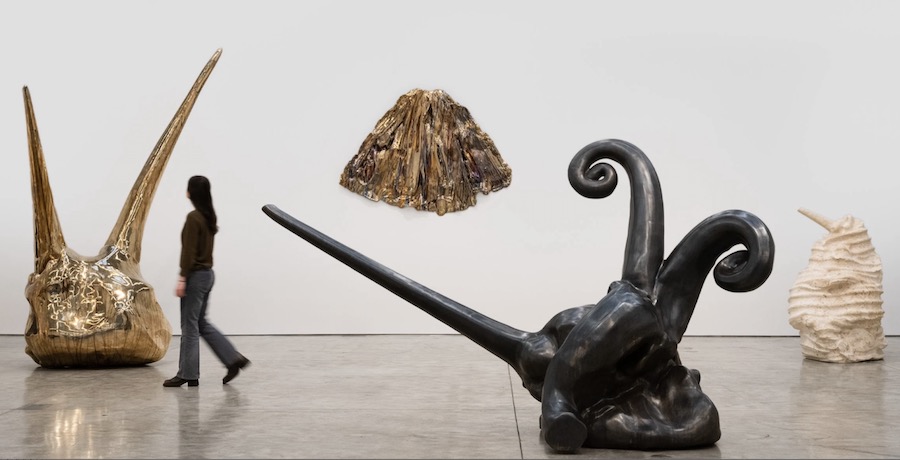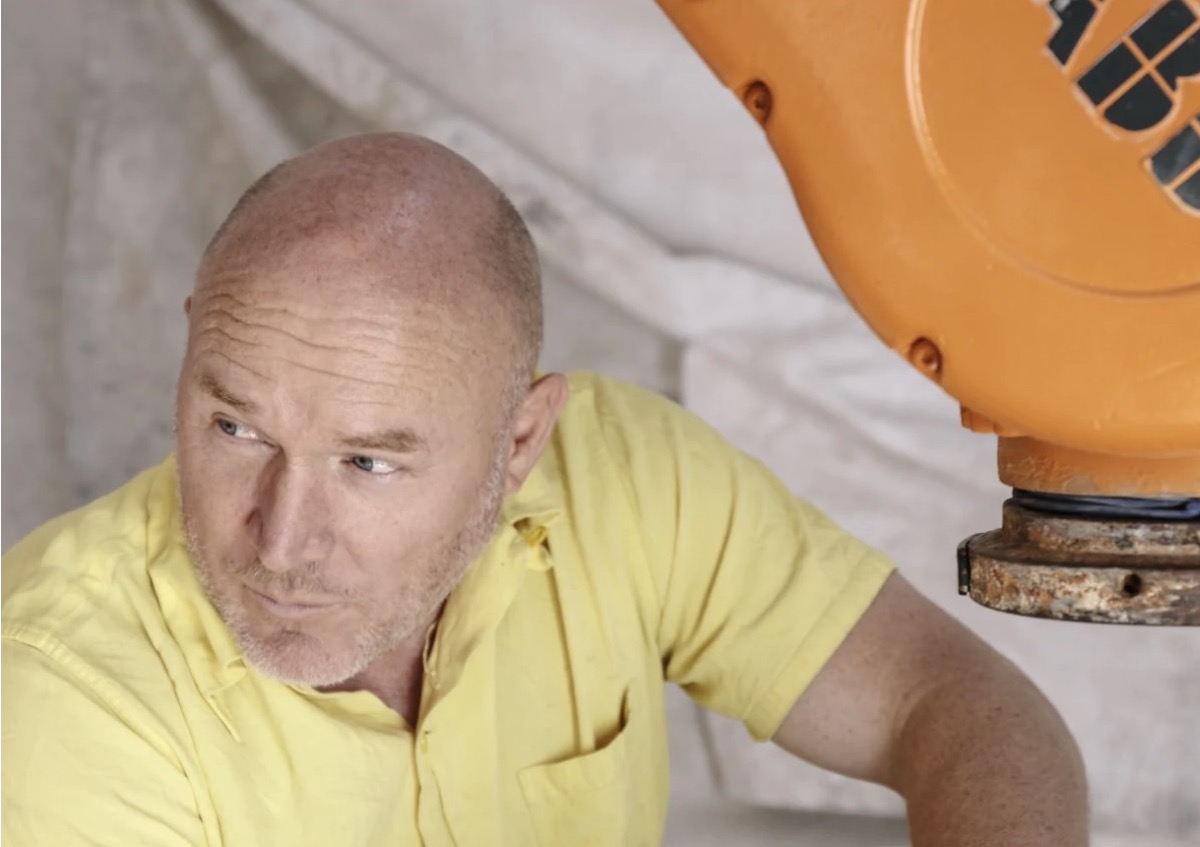Reported: Alma Allen will take the reins for the U.S. Pavilion at the 2026 Venice Biennale, opening next May — though no one is quite ready to say so out loud. The Utah-born, Mexico-based artist has been commissioned, along with Jeffrey Uslip, to serve as the pavilion’s curator. The catch? The announcement can’t go public until the current government shutdown ends. Bureaucracy before art, as always.
The news surfaced through The Baer Faxt, the art world’s favourite rumour mill in newsletter form. If true, it marks a quietly surprising choice. Allen isn’t the household name one might expect for a national pavilion, which often leans toward blue-chip stars with significant institutional representation. His predecessors include Jeffrey Gibson, Simone Leigh, Mark Bradford, and Ed Ruscha — artists whose careers orbit the upper stratosphere of the art market. Allen, by contrast, works from Tepoztlán, a quiet town south of Mexico City, shaping immense pieces of stone, wood, and bronze with a mix of traditional hand-carving and custom-built robotics.
For anyone familiar with Allen’s practice, the idea of his forms occupying Venice’s neo-Palladian pavilion is an intriguing prospect. His works feel less like monuments and more like fossils from an alternate evolution — abstract, sometimes animate, always tactile. “The sculptures are often in the act of doing something,” Allen once said. “Even though they seem static as objects, they are not static in my mind.”

Still, the logistics of his appointment remain murky. The U.S. Pavilion is typically commissioned through an institution — normally, the Whitney, the Guggenheim — yet there’s no confirmation of any such partner here. ARTnews traced a page on the American Arts Conservancy website dedicated to the 2026 U.S. Pavilion, suggesting that it might be the organising body. The Conservancy, a newly minted nonprofit founded in July, lists Uslip on its advisory council and describes its mission in predictably broad terms: “advancing the legacy of American artists through preservation, education, and global cultural engagement.”
Uslip, currently independent, last curated the Malta Pavilion in 2022. Before that, he was chief curator at the Contemporary Art Museum St. Louis — until his abrupt resignation in 2016 after the fallout from a controversial Kelley Walker exhibition. That’s a history he’s unlikely to want dredged up, though it inevitably will be.
Allen’s gallery affiliations, too, are in transition. He was once with Blum & Poe, then Kasmin, which recently folded into the newly branded Olney Gleason. His name appeared on their artist roster until just last month. Sources say he’s now in talks with Perrotin, though the gallery hasn’t confirmed.
Born in 1970, Allen has had two major museum surveys — one in 2018 at the Palm Springs Art Museum and another last year at the Museo Anahuacalli in Mexico City. Earlier this year, a fleet of his sculptures quietly occupied twenty blocks of Park Avenue in New York, an understated victory lap for an artist who prefers to work far from the noise.
The American Pavilion selection process has already been chaotic. The Washington Post reported that Robert Lazzarini had initially been chosen, only for the State Department to drop the proposal over “bureaucratic” concerns. Meanwhile, fringe figures like Andres Serrano and far-right blogger Curtis Yarvin loudly declared their own intentions to represent the U.S., though it’s unclear if either actually applied.
The call for proposals itself carried new political overtones. It asked for art that “reflects and promotes American values” and “fosters peaceful relations” — phrases that read like coded instructions from an administration wary of dissenting voices—the result: a field narrowed by ideology and uncertainty.
Money, as always, is another factor. The U.S. government offers only $375,000 toward a pavilion that can cost several million to produce. Gibson’s 2024 outing was rumoured to run $5 million; Leigh’s, $7 million. Private fundraising fills the gap, but not without its share of stress.
Other nations are already locked in: Lubaina Himid for the U.K., Yto Barrada for France, Henrike Naumann and Sung Tieu for Germany. If the rumours hold, Alma Allen will join them — a quiet figure representing a country that can’t quite get its own arts funding straight.
Alma Allen’s sculptures don’t sit still. They hum with a kind of private tension — part psychological charge, part physical curiosity — as if they’re thinking their way through matter itself. His work probes what it means for an object to feel alive, and how form and material can communicate in the gaps where language fails. It’s an old question, really, but Allen keeps asking it with the urgency of someone who doesn’t believe in final answers.
He’s known for drawing from nature without imitating it — an odd synthesis of the organic and the alien. His sculptures, whether chiselled from stone, carved from wood, or cast in bronze, often appear as if they could have grown there naturally. Each piece is born from something found: a block quarried by hand, a fallen tree, a fragment of landscape pulled into the studio. The results are dense, sensual things, heavy with suggestion. Bronze looks as if it might melt. Wood twists into gestures that feel half-animal, half-memory. Stone takes on the softness of skin.
There’s a quiet humour too, a sense of play that prevents his work from lapsing into reverence. You can imagine these sculptures as creatures with their own secret errands — moving when no one’s watching. Allen has said he sees them as being “in the act of doing something,” and that tracks. They resist being pinned down.
His process is a strange marriage of the archaic and the futuristic. He begins with small clay maquettes, remaking and reworking them until the proper form emerges. Then, using a robotic device he built himself, he scales them up — a kind of mechanical extension of his hand. The technology doesn’t replace intuition; it just widens its reach. Once the shape takes hold, Allen finishes everything himself, sanding and polishing until the surfaces have an impossible tenderness, a softness that undercuts their sheer weight.
The foundry at his studio in Tepoztlán, Mexico, makes this full-circle process possible. There, bronze is poured and cooled within earshot of the mountains, every step contained on site. The work that comes out of this setting feels both ancient and strangely new — as if a surrealist, a craftsman, and a machine had all shared the same dream.
You can trace specific lineages in his work — Brancusi, perhaps, or Beckett, both interested in paring form down to its essentials, both drawn to the absurd persistence of creation. But Allen’s sculptures aren’t about influence. They’re about staying with the act itself, about testing how far a material will go before it refuses.
And maybe that’s the point. The pieces don’t aim to represent; they insist on simply being. Imperfect, tactile, alive in their stillness — like relics of a world that’s always just coming into focus.
It’s a slightly odd choice. And maybe that’s precisely what the U.S. Pavilion needs right now: a sculptor who makes stillness move.
Top Photo: Courtesy Kasmin Portrait by Diego Flores

